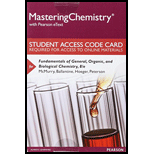
(a)
Interpretation:
The number of covalent bonds and the lone pairs of electron in the molecule formed by reaction between given atoms is to be drawn by using electron-dot symbols with lines showing as covalent bonds.
Concept introduction:
Covalent bonds are formed by sharing of electrons between atoms.
The valence electrons of Aluminum are 3 electrons.
The valence electrons of Bromine are 7 electrons.
(b)
Interpretation:
The number of covalent bonds and the lone pairs of electron in the molecule formed by reaction between given atoms is to be drawn by using electron-dot symbols.
Concept introduction:
Covalent bonds are formed by sharing of electrons between atoms.
The valence electrons of Carbon are 3 electrons.
The valence electrons of Fluorine are 7 electrons.
(c)
Interpretation:
The number of bonds formed by each atom is the given molecule and the structure of the given molecule using electron-dot symbols.
Concept introduction:
Ionic bonds are formed by complete transfer of electrons from one atom to other atom.
The valence electrons of Cesium are 1 electron.
The valence electrons of Iodine are 7 electron.
(d)
Interpretation:
The number of bonds formed by each atom is the given molecule and the structure of the given molecule using electron-dot symbols.
Concept introduction:
Ionic bonds are formed by complete transfer of electrons from one atom to other atom.
The valence electrons of Zinc are 1 electron.
The valence electrons of Fluorine are 7 electron.
(e)
Interpretation:
The number of bonds formed by each atom is the given molecule and the structure of the given molecule using electron-dot symbols.
Concept introduction:
Ionic bonds are formed by complete transfer of electrons from one atom to other atom.
The valence electrons of Lithium are 1 electron.
The valence electrons of Chlorine are 7 electron.
Want to see the full answer?
Check out a sample textbook solution
Chapter 4 Solutions
Mastering Chemistry with Pearson eText -- Standalone Access Card -- for Fundamentals of General, Organic, and Biological Chemistry (8th Edition)
- How does the bond energy of a double bond compare to that of two single bonds between the same elements? How does this relationship explain the types of reactions that compounds with double bonds undergo?arrow_forward. Give the name of and symbol for an element with this number of valence electrons.a) 2b) 6c) 8arrow_forwardAn ion has 15 protons, 16 neutrons, and 18 electrons. The symbol for the ion is 31P3+. 31P3-. 31Ar3+. 34S+. 34S-.arrow_forward
- Elemental analysis of a compound with molar mass 342.3 g/mol gives the following mass percent composition: C 42.11%, H 6.48%, O 51.41%. Find the molecular formula of the compound. Enter your answer in the space below using the following format: if the molecular formula of a compound containing elements X, Y, and Z is X2YZ3 enter your answer as X2YZ3.arrow_forwardIdentify the compound represented by the figurearrow_forwardSo the correct answer is hydrogen bonds?arrow_forward
 Principles Of Radiographic Imaging: An Art And A ...Health & NutritionISBN:9781337711067Author:Richard R. Carlton, Arlene M. Adler, Vesna BalacPublisher:Cengage Learning
Principles Of Radiographic Imaging: An Art And A ...Health & NutritionISBN:9781337711067Author:Richard R. Carlton, Arlene M. Adler, Vesna BalacPublisher:Cengage Learning

